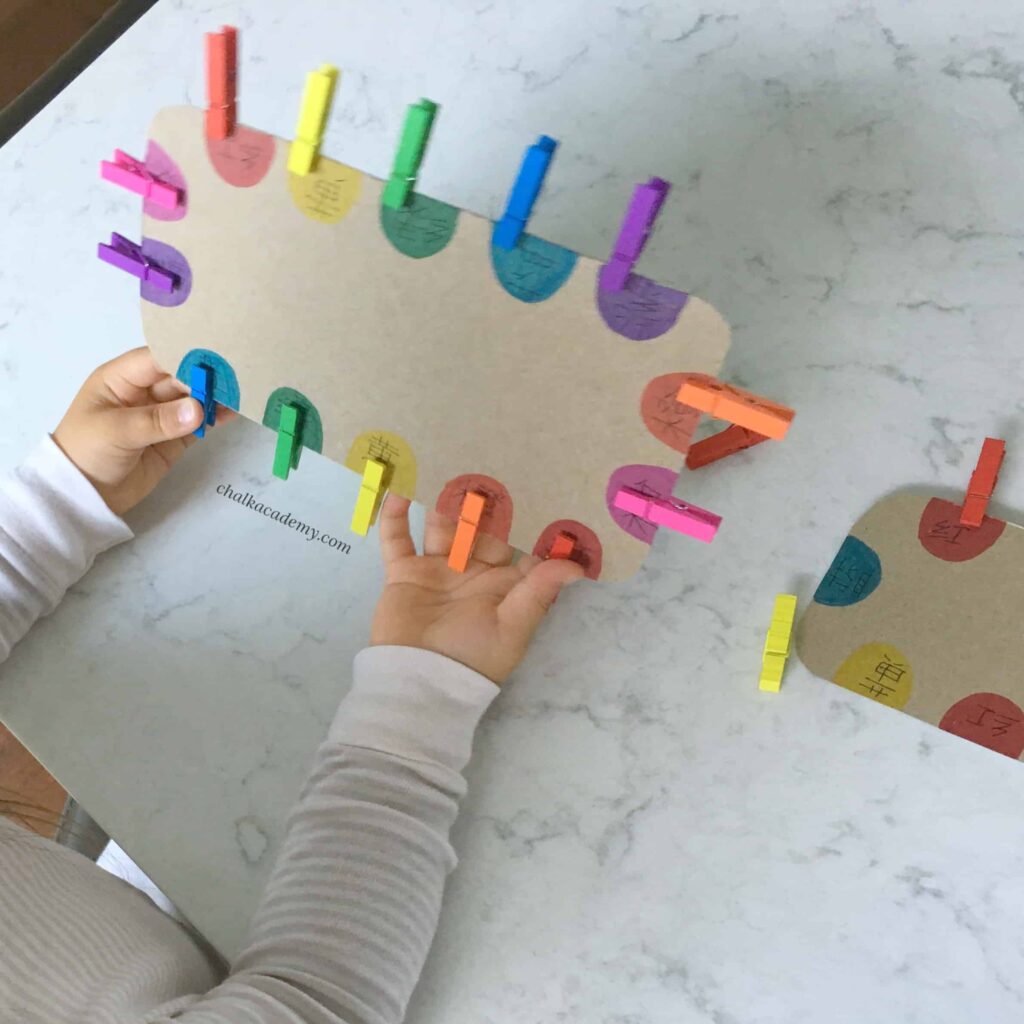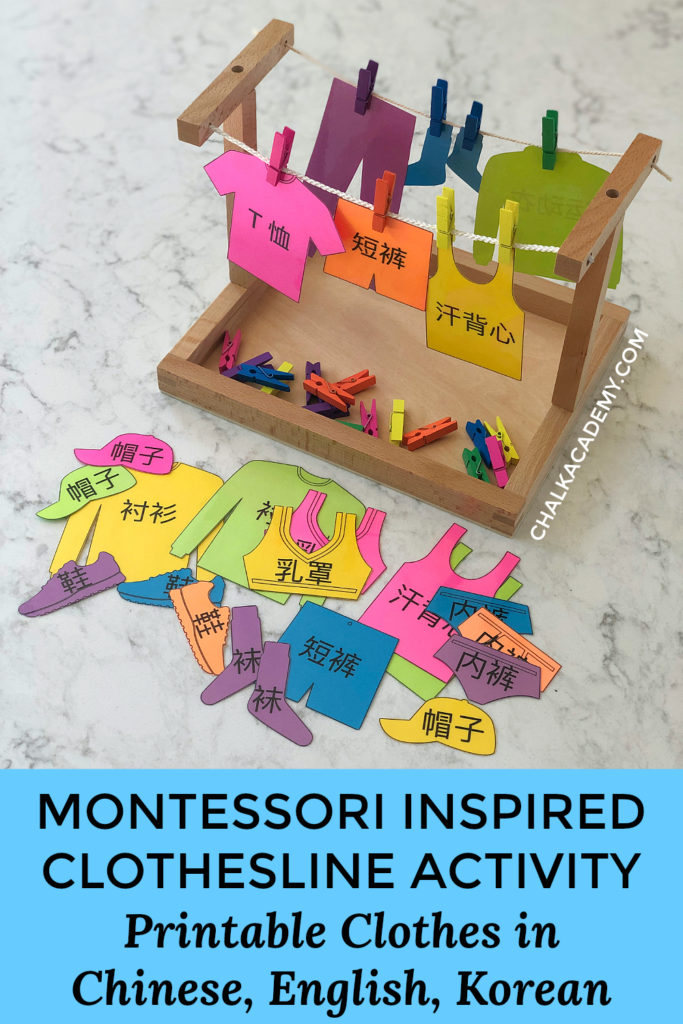Clothespin Color Matching with Fine Motor Skills and Word Recognition
A few years ago, I created a simple and fun clothespin color matching for my daughter with recycled cardboard. This was one of my daughter’s favorite fine motor activities between the ages of 2 and 4 years old!
Now that my son is 2.5 years old, he is working on color recognition and strengthening fine motor skills everyday. I can’t believe how fast he is growing! Already, he can play with big sister’s old activities!
Color matching, pegging, and combining these 2 skills
In this post, I’ll share:
- Tips for teaching colors to toddlers
- Benefits of pegging activities
- Considering when a child is developmentally ready for certain activities
- Implementing language into activities and important translations
- What you need for clothespin color matching
- How to set up this activity

Chalk Academy is reader-supported. Some of the links are affiliate links. When you buy something through an affiliate link, we may earn a very small commission at no additional cost to you. More details here.
1. How to teach children colors
Color introduction through descriptive observations
From infancy, be specific when describing items that your child encounters in daily routine. Children naturally learn through conversation about everything in their little world!
For example, tell your child you are going to put on his or her BLUE shirt and BROWN pants. You can also point out that daddy is also wearing a BLUE shirt and BROWN pants and show excitement about matching (and twinning!).
In addition, when we see a black piece of paper or a black computer, I’ll show my toddler that the color matches our black hair.
While it’s helpful to narrate so kids learn the language, I also want to stress that we should remain quiet at times so kids have a chance to think, observe, and discover colors on their own.
Related: Usborne Big Book of Colors Plus Color Learning Activities
Focus on a few colors at a time
When a child is between ages 1 to 3, you can spend a few weeks or months focusing on just one or two colors at a time with plenty of repetition.
Some parents start with the primary colors, then secondary colors, and then review the whole rainbow.

2. Clothespin color matching: Benefits of pegging activities
Instead of buying toys and activities that your child will outgrow, clothespin color matching is an easy-to-make project that can benefit your child’s development.
Toddlers and preschoolers are in the prime stage of learning colors, and this activity encourages visual discrimination by matching.
In addition, toddlers and preschoolers are learning to use their hand muscles in complex ways. They want to squeeze, pull, grasp, and pinch everything!
Manipulating clothespins hones in on those practical skills and paves the way for pencil grip and future writing.
Related: Number Matching With Pegs – 3 Easy Ways

3. Clothespin color matching: When is a child ready for this activity?
Consider a child’s developmental level
A few months ago after my son mastered the basic colors of the rainbow, I was excited to take out this clothespin activity from storage!
Initially, the activity was frustrating for him. Although his little fingers could open large clothespins and chunky kitchen bag clips, these mini clothespins were difficult to manipulate. He complained, “I don’t like this, Mommy! Hmmph!”
I realized that he was not yet ready for the activity, but I didn’t have large clothespins to replace the mini ones. Therefore, I put it away and found other fine motor activities that excited him, like this bottle cap activity!
Now, the clothespin color matching activity is the perfect challenge for his level – not too hard and not too easy!

Trial and error is normal when introducing activities!
I wanted to share our experience, because many parents are worried when their child doesn’t seem interested in an activity.
In reality, they might not be developmentally ready for it or they are focusing on developing other skills. Sometimes, we need to set the activity aside and let our children come back to it later. On the other hand, an activity might be unappealing if it’s too easy.
Sometimes it takes time and trial and error; keep observing your child and be flexible with expectations!
At the very least, this activity costs almost nothing and is recyclable!
Related: Fun & Educational Chinese Activities – A How-To Guide

4. Implementing language into activities
Since Chinese is one of my children’s 3 languages, I included Chinese characters with this activity for word exposure.
Mandarin Chinese is a minority language for our family, which means that my children rarely meet other people who speak Chinese. In addition, we don’t see Chinese characters unless I introduce them at home.
Therefore, I try to make our minority language as fun and relevant as possible by including Chinese in these activities!
Important vocabulary in Chinese, Pinyin, and English
For parents who are learning a second language with their children like me, the translations below are in simplified Chinese, traditional Chinese, and Hanyu Pinyin!
- Clothespin / Peg: 衣夹 / 衣夾 (Yī jiā)
- To clip: 夹 / 夾 (Jiā)
- Color: 颜色 / 顏色 (Yánsè)
- Primary color: 原色 (Yuánsè)
- Secondary color: 二次色 (Èr cì sè)
- Red: 红 / 紅 (hóng)
- Orange: 橙 (chéng)
- Yellow: 黄 / 黃 (huáng)
- Green: 绿 / 綠 (lǜ)
- Blue: 蓝 / 藍 (lán)
- Purple: 紫 (zǐ)
- Pink: 粉 (fěn)

5. Clothespin color matching: what you need
Take out your collection of colorful clothespins (eg, pegs), grab some markers, and find any piece of cardboard or paper.
- Colorful clothespins
- Cardboard (eg, tissue box, cereal box, packaging material)
- Black Sharpie marker
- Colorful Sharpie markers

Voilà! Now you have an easy color and word learning activity!
6. Clothespin Color Matching: How to Set up the Activity
- Color spots on edge of paper or cardboard. I made 3 different cards – one with all colors, one with primary colors, and one with secondary colors
- Label each colorful spot with corresponding character: 红, 橙, 黄, 绿, 蓝, 紫 (hóng, chéng, huáng, lǜ, lán, zǐ/red, orange, yellow, green, blue, purple)
- Clip clothespins to matching color
- Discuss which colors are primary (红, 黄, 蓝) and which are secondary (橙, 绿, 紫)

Have you tried Clothespin Color Matching with your child(ren)?
If you try this Clothespin Color Matching activity, let us know in the comments below!

More hands-on learning activities for children
Happy playful learning, friends!